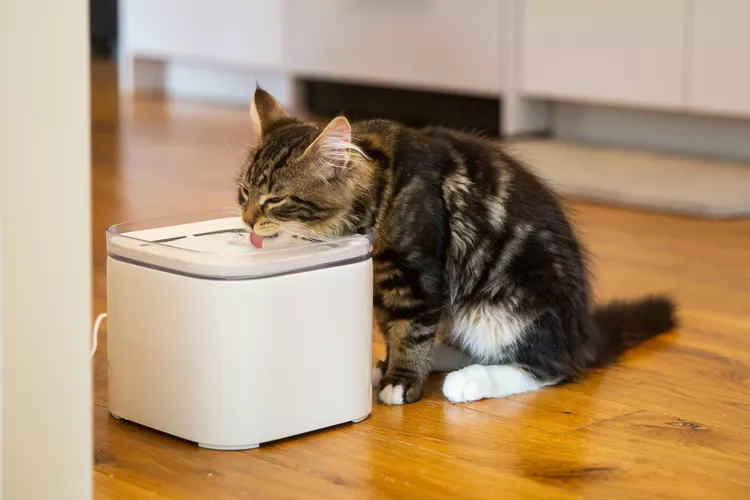
Cats need fresh drinking water every day for optimum health. Water is essential for helping the kidneys flush out toxins from the blood. Whether from illness or lack of fluids, dehydration in cats is dangerous, and if not treated, can lead to death.
Cats in kidney failure, either acute or chronic renal failure, often require extra fluids given either intravenously or by subcutaneous drip. The latter therapy is often carried out at home and is relatively easy to learn and perform. With most cats, the improvement after these treatments is significant and visible.
Excessive drinking of water can be a red flag for feline hyperthyroidism or feline diabetes. While cats may instinctively drink more during hot weather, it is important, as with all cats' habits, to know how much a cat drinks normally. If they suddenly start consuming large quantities of water and also shows other symptoms, an immediate veterinary consultation is indicated.
Cats' body tissues consist of about 67 percent water. Coincidentally, that is approximately the percentage of water in the prey they catch and eat in the wild. In contrast, dry cat food contains between 6 and 10 percent water and canned cat food has at least a 75 percent moisture content, making it a good source of water. Therefore, a cat on an all-dry food diet would require more supplemental drinking water than a cat on an exclusive raw or canned food diet. Likewise, a cat on a combination of dry and canned cat food also needs more drinking water.
Dr. Jennifer Coates, in an article for PetMd.com, created a formula suggesting that a 10-pound adult cat on a dry food diet needs about a cup of water a day. The same cat on a canned diet needs about a third a cup of water daily.

Tetanus in Dogs
Tetanus is an infection caused by bacteria found in soil. It can cause severe symptoms in dogs and even lead to death if not treated promptly.
8 Common Dog Paw Problems
It is important to check your dog’s paws regularly for any issues and take steps to keep them healthy and protected.
Common Injuries in Dogs and How to Treat Them
Learn about the most common injuries in dogs—whether in their legs, spine, tail, or eye—and how you should treat them with this helpful list.
Can Cats Eat Strawberries? How to Safely Share This Summer Berry
Although cats are primarily meat eaters, strawberries may be an interesting and tasty snack for your feline friend. Find out the risks of feeding strawberries to cats and how to safely let your cat enjoy this fruit.
Is Shrimp Bad For Dogs?
Shrimp can be a healthy, nutritional food for people but can dogs eat them, too? What are the main concerns with feeding shrimp to your dog?
Dog Food Basics
Are you feeding your dog the best way possible? Check out these dog feeding tips to keep your dog healthy and happy.
Rhodesian Ridgeback: Dog Breed Characteristics & Care
The Rhodesian ridgeback is a large hunting dog with a high prey drive. Learn about the breed's history, exercise needs, and more.
Berger Picard: Dog Breed Characteristics & Care
The Berger Picard is a French herding dog with a friendly smile and shaggy beard. Learn about its history, health, exercise needs, and more.
Spanish Water Dog: Breed Characteristics & Care
In the hands of an expert owner, the Spanish water dog shines as an active and faithful companion. Learn about its history, training, and more.
Cat Bunting Behavior: What Does It Mean?
Cats rub their heads against prominent objects to leave scent markings as a part of scent communication.
How to Train Your Cat to Stop Urine Marking
Most male (and some female) house cats will mark territory at some point. Learn the causes or cat urine marking and how to prevent this annoying behavior.
7 Reasons Why Cats Love Bathrooms
Why do cats follow you to the bathroom? Many cats—strangely enough—love the bathroom! Find out why cats seem to love bathrooms so much.
Leptospirosis in Cats
Leptospirosis is rare but potentially fatal in cats. Learn the causes, treatment, and prevention.
Ear Infections in Cats
An ear infection must be treated based on the source of irritation, which may be internal or external. Learn the causes, treatment, and prevention.
Insects That Are Toxic to Cats
Can cats eat bugs? Some bugs can cause injury or illness to your cat, while others are relatively harmless.
Testing for Contagious Feline AIDS (FIV)
Cats should be tested for the contagious feline immunodeficiency virus or FIV. Cats that are positive for the virus usually live normal lives.
Why Does My Dog Pee on My Bed?
Is your dog peeing on your bed? Find out why your dog is having urinary accidents on the bed and learn what to do about it—plus how to stop the habit.
Why Almost Any Dog Can Do Agility Training
Why Almost Any Dog Can Do Agility Training
How to Train Your Dog to Shake Paws
Shaking paws is a fun dog trick that most dogs pick up rather quickly Learn how to train your dog to shake in just a few simple steps.
14 Asian Cat Breeds And Their Rich Hiss-tories
Find out more about the cat breeds that originated from Asia. Some breeds include the Persian, Oriental shorthair, and Japanese bobtail.